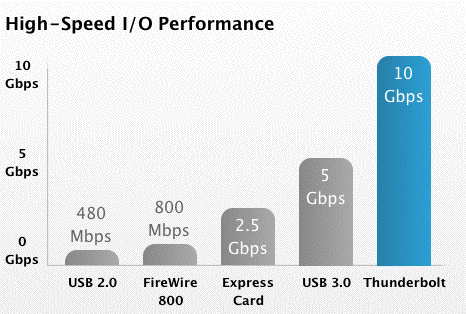How we'll roll with Thunderbolt

Intel and Apple are underselling Thunderbolt - for good reason - but make no mistake: Thunderbolt is part of of your future. Here's how Thunderbolt will roll out - and why.
Performance Thunderbolt consists of 2 10 Gbps bi-directional (full duplex) channels. Each channel can handle 10 Gbps in and 10 Gbps out at the same time.
USB 2.0 also runs bi-directionally at 240 Mbit/sec each way. Which is where the 480 Mbit/sec number you see everywhere comes from - even if you never see it in real life.
If Thunderbolt was promoted the way USB 2.0 was, ApTel would be claiming 40 Gbps. Here's how Apple positions it:

And here's how LaCie positions it:
System performance The limiting factor, especially on notebooks, will be system bandwidth. You'll need dual high-performance SSDs on a Sandy Bridge chipset to use half of a single Thunderbolt channel.
Desktops won't be much better until the next generation of chip technology kicks in. You'll see a benefit today if you're editing full HD video and you have Thunderbolt peripherals. Otherwise it's just bragging rights.
Peripheral performance Peripheral availability and cost will be the main reason Thunderbolt doesn't take off fast. Figure the 1st storage peripherals will come out this summer from LaCie.
But the cost will deter most consumers. Prices will be high because Thunderbolt peripherals other than displays will be high-performance.
With storage, that means a couple of SSDs in an array, like LaCie's announced but not shipping 'til summer Little Big Disk. The LBD will probably cost more than most WinTel notebooks.
Other peripherals Beyond displays and storage you will see specialized high-speed peripherals, such as prosumer and pro HD camcorders, instrument interfaces for engineering and science and compute cluster software. Expect these to dribble out as vendors - other than Sony, who also seems committed to Thunderbolt - discover its advantages.
Expect to see Thunderbolt-to-10-GigE adapters as well. High end desktop machines will be going native 10 GigE by the end of the year, but why bother on a Thunderbolt notebook?
I'd also expect to see the Fibre Channel storage protocol over Thunderbolt through an adapter. They won't be cheap, but for the first time a notebook could have access to an FC SAN.
Compute cluster? Thunderbolt is very low latency - a maximum of 8 nanoseconds in a fully configured 8 node fabric - which rivals the much more costly - and expandable - Infiniband. Infiniband is widely used in high performance computing and in EMC's Isilon NAS clusters.
A cluster of 6 quad-core notebooks on a Thunderbolt fabric could handle a lot of video rendering and transcoding while on the run. Add a fast flash array and you've got a 50 lb. battery-powered HD video production studio. Nice.
Thunderbolt vs USB 3.0 Despite Thunderbolt's advantages, USB 3.0 is fast enough for the majority of users. Unlike when USB 1.0 debuted, users aren't looking for relief from balky, incompatible and slow interfaces like ADB, parallel printer ports, PS/2 and SCSI.
But USB 3.0 can run over Thunderbolt, so Mac users shouldn't have long to wait for USB 3.0 adapters. The early adapters won't be cheap, but embedding them into USB 3.0 hubs would blunt the sticker shock.
It would be nice - but I'm not holding my breath - for Apple to write USB 3.0 drivers. Windows support for 3.0 should be much better.
The Storage Bits take Make no mistake: Thunderbolt is a solution to high-end problems, not the consumer mainstream, today. But if Intel is wise, they'll drive Thunderbolt's pricing down fast to make it more attractive than FireWire was at its peak.
But consumers will gradually learn to consume a lot more bandwidth and they always like simpler cabling. It will take a few years, but if it is priced correctly, Thunderbolt will become a mainstream consumer technology.
Even better, it will become a mainstream server technology, faster, simpler and cheaper than the current hodge-podge of interconnects. Blade vendors should learn to love it.
I'll be at NAB in Las Vegas, where I expect to see more Thunderbolt announcements - especially from Sony - and also from storage vendors. As more Thunderbolt pro gear rolls out, WinTel vendors will have to choose: concede the entire high-end market to Apple, or dig in for a fight.
Given Apple's high-end dominance, I'd expect only HP and Dell to to join the Thunderbolt brigade along with a few workstation mobo's. Thunderbolt will cement Apple's stranglehold on the creative pro market.
Update: Jason Hiner suggests Forget Intel's Thunderbolt, Wireless USB is the game-changer. Except for Wi-Fi, I've never had a satisfactory wireless peripheral. Including Apple's Bluetooth Magic Trackpad that went hinky when I upgraded the video card on my Mac Pro. Slower, flakier and probably just as expensive - wUSB is not replacing any wired peripheral in my life. End update.
Comments welcome, of course. Do you manage or architect systems with internal storage? My firm is doing a survey for a major IT supplier and would like your input. Learn more at Internal Storage Survey.